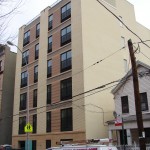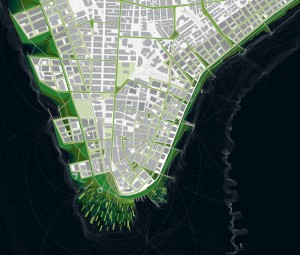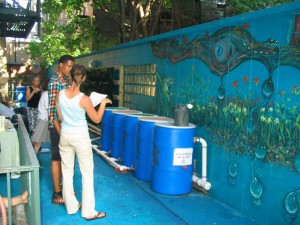March Green Building Forum: Sustainable Stormwater Management
March 7, 2011
Whether you’re a green building professional, student, or just plain interested in water, the March forum promises to open your eyes to a new way of thinking about those April showers. Our March speakers provide a wealth of knowledge on managing urban runoff, and promise to share exciting, creative solutions that will improve NYC. GreenHomeNYC’s invited speakers are experienced practitioners and researchers who have designed rainwater collections systems for buildings, created innovative public spaces to attenuate stormwater flows, and implemented new technologies in urban and controlled environments to help the green building community understand how we can reduce infrastructure costs and improve water quality. Event Details: Wednesday, March 16, 6:30 – 8:00 PM Please arrive early – We will start promptly at 6:30! TOTO USA NYC Showroom 25 Mercer St. (Between Canal and Grand) Please RSVP. AIA credits available, scroll down for details. Speakers: Welcome by GreenHomeNYC Jack Coogan, OCV Architects Adam Yarinsky, ARO and Susannah Drake, dlandstudio Tatiana Morin, NYC Soil and Water Conservation District Thomas O’Connor, US EPA Office of Research and Development The Green Building Forum is held on the third Wednesday of each month (except December) at 6:30 PM and features presentations by green building practitioners followed by discussion. The events are always free and open to the general public. About the Speakers and Projects Building Scale Solutions: OCV Architects Presented by: Jack Coogan, RA, Principal – OCV Architects
Decatur Green
Decatur Green, amulti-family building located in the Bronx, was one of the first buildings to implement the Enterprise Green Communities Criteria. The facility showcases many green features including a rainwater collection system for toilets and landscaping. Mr. Coogan will discuss the benefits and challenges of minimizing stormwater runoff on small, intensely built lots. For more information, see the entry for Decatur Green in GreenHomeNYC’s Green Buildings Database.
Jack Coogan is a founding partner of Oaklander, Coogan & Vitto (OCV) Architects, bringing the firm over 30 years of experience designing, renovating and rehabilitating projects of varying sizes and types throughout the City and State of New York. A licensed architect in the State of New York and a LEED Green Associate, he has been Project Architect for numerous housing developments, single-family homes, corporate offices, restaurants, educational facilities and community centers for a variety of private, corporate, non-profit and government clients. About OCV Architects OCV is a full-service architectural firm with specialties in green design, adaptive reuse, historic preservation and rehabilitation. OCV Architects have been designing innovative, quality projects that reflect our sense of community and dedication to affordable housing in New York City and the surrounding area for over 30 years. OCV has collaborated with many organizations throughout the region, most notably the Fordham Bedford Housing Corporation on the implementation of sustainable construction and rehabilitation principles for over 1000 affordable units. Recent projects employing green design strategies include Decatur Green, 2241 Webster Ave., Jacob’s Place, and Serviam Gardens senior living complex. Neighborhood Scale Solutions: Architecture Research Office and dlandstudio Presented by: Adam Yarinsky, FAIA LEED AP, Founding Partner – Architecture Research Office Susannah Drake, AIA, ASLA Principal – dlandstudio, LLC Comprising “Team Zero” in the Museum of Modern Art’s recent “Rising Currents” exhibit, ARO and dlandstudio created a comprehensive strategy for meeting stormwater and storm surge challenges in Lower Manhattan. Their proposal secures the city against future sea level rise but also resolves the present-day crisis of combined sewer overflows. Mr. Yarinsky and Ms. Drake will talk about the design as well as some of the considerations when addressing runoff at a larger scale. Adam Yarinsky, FAIA, LEED AP is Principal and co-founder of Architecture Research Office. Adam holds an undergraduate degree in Architecture from the University of Virginia and received his Master of Architecture from Princeton University. Adam has led ARO’s most distinctive projects for institutional clients such as Princeton University, New York University, and Colorado College. Adam has guided ARO through a number of recognizable projects including the SoHo Loft, the Donald Judd Home+Studio Museum in New York City and the firm’s ongoing Design Excellence Contract for the New York City Department of Design and Construction. He is the co-author of On the Water: Palisade Bay (MoMA/Hatje Cantz), the book that inspired the 2010 “Rising Currents” exhibit at the Museum of Modern Art. Adam has served as both Eliel Saarinen Professor and Sanders Teaching Fellow at the University of Michigan, the Shure Professor at the University of Virginia. In addition, Adam has taught at numerous other universities across the county and his articles have appeared in 306090, Dimensions, and Places Journal. With Stephen Cassell, Adam is a 2010 recipient of the American Academy of Arts and Letters’ Architecture Award. Susannah C. Drake, AIA, ASLA is the Principal of dlandstudio llc, an award winning multidisciplinary design firm that includes landscape architects, urban designers, sculptors, scientists and architects. Susannah received a Bachelors of Arts Degree from Dartmouth College and MArch and MLA degrees from the Harvard Graduate School of Design. She is the recipient of grants from the Graham Foundation, the James Marston Fitch Foundation and the New York State Council on the Arts for research on campus landscapes and large scale urban infrastructure projects. Susannah is the trustee and Past-President of the New York ASLA, is on the board of the Van Alen Institute, serves on the campus design advisory board at Dartmouth College, and is a former director of the Fine Arts Federation and a former member of the Directors Council of New Yorkers for Parks. In addition to her professional practice, she is an adjunct professor of design at the Harvard Graduate School of Design and at City College of New York. About “A New Urban Ground”: Architecture Research Office and dlandstudio ARO has worked on the impact of climate change, sea level rise, and the future of New York City’sinfrastructure and ecology since 2006. Invited by the Museum of Modern Art (MoMA) to develop a conceptual project for Lower Manhattan, ARO chose to work with landscape architect Susannah Drake of dlandstudio. Rising Currents appeared on exhibit at MoMA from March through October 2010.
A New Urban Ground
Briefing – http://www.epa.gov/nrmrl/pubs/600f09038/600f09038.pdf
Report on infiltration rates – http://www.epa.gov/nrmrl/pubs/600r10083/600r10083.pdf
CEC learning objectives
The participant will be able to define the terms: combined sewage overflow (CSO), a combined sewage overflow event and describe at least three harmful affects that an overwhelmed stormwater system has on New York City’s water quality and its potential risks to the population and the environment.
The participant will be able to discuss at least four sustainable design strategies architects, designers and engineers are utilizing on small and large scale projects to minimize stormwater run off and CSOs. The participant will be able to summarize how a stormwater capture monitoring program is developed and implemented and the benefits and challenges of creating stormwater pilot programs on the local level in NYC. The participant will be able to explain how stormwater research is conducted by the EPA and the role such investigations and findings play in the development of local, state and federal legislation.
